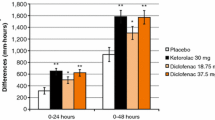Summary
The objective of this study was to compare the efficacy and tolerability of single doses of a new oral formulation, diclofenac dispersible, with parenteral ketorolac in patients with postoperative pain following orthopaedic surgery. In this double-blind, double-dummy, between-patient study, 55 adult inpatients experiencing moderate-to-severe pain within 2 hours after surgery were randomly allocated to receive diclofenac dispersible 50mg orally or ketorolac 30mg intramuscularly. The primary efficacy variable was pain intensity at 15 minutes. Secondary efficacy variables included pain relief and global evaluation of efficacy by patient and investigator. Diclofenac dispersible was significantly superior to ketorolac with respect to the primary efficacy variable (p = 0.012). The area under the pain intensity-time curve from zero to 6 hours (AUC0–6) for reduction in pain intensity and the peak intensity difference values were also superior for diclofenac, although the differences just failed to reach statistical significance (p = 0.06). Pain relief scores were clinically and numerically superior in diclofenac recipients compared with ketorolac recipients over the 6-hour observation period. AUC0–6 for pain relief was significantly higher for the diclofenac-treated group compared with ketorolac-treated patients (p = 0.0002). Both treatments were well tolerated.
In conclusion, these data show diclofenac dispersible to have a faster onset of action and superior efficacy overall compared with intramuscular ketorolac in the management of pain after orthopaedic surgery. Diclofenac dispersible therefore provides a new oral alternative to parenteral nonsteroidal anti-inflammatory agents in the management of postoperative pain.
Similar content being viewed by others
References
Greaves MW, Sondergaard JS. Prostaglandin E: effect on human cutaneous vasculature and skin histamine. Br J Dermatol 1971; 84: 424–8
Cashman J, McAnulty G. Non-steroidal anti-inflammatory drugs in perisurgical pain management. Drugs 1995; 49(1): 51–70
Moote C. Efficacy of nonsteroidal anti-inflammatory drugs in the management of postoperative pain. Drugs 1992; 44 Suppl. 5: 14–30
Nuutinen LS, Laitinen JO, Salomaki TE. A risk-benefit appraisal of injectable NSAIDs in the management of post-operative pain. Drug Saf 1993; 9(5): 380–93
Cashman JN. Non-steroidal anti-inflammatory drugs versus post-operative pain. J R Soc Med 1993; 86: 464–7
Todd PA, Sorkin EM. Diclofenac sodium — a re-appraisal of its pharmacodynamic and pharmacokinetic properties, and therapeutic efficacy. Drugs 1988; 35: 244–85
Investigator’s brochure on diclofenac dispersible (GP44871), 1989; data on file at Ciba-Geigy Limited, Basel, Switzerland
Bakshi R, Rotman H, Shaw M, et al. Double-blind, multicentre evaluation of the efficacy and tolerability of diclofenac dispersible in the treatment of acute soft-tissue injuries. Clin Ther 1995; 17: 30–7
Bakshi R, Frenkel G, Dietlein G, et al. A placebo-controlled comparative evaluation of diclofenac dispersible versus ibuprofen in post-operative pain after third molar surgery. J Clin Pharmacol 1994; 34: 225–30
DeAndrade JR, Maslanka M, Maneatis T, et al. The use of ketorolac in the management of postoperative pain. Orthopedics 1994; 17(2): 157–66
Armitage P, Berry G. Statistical methods in medical research. Oxford; Blackwell Scientific Publications, 1987: 179–85
Bakshi R, Ezzet N, Fedele N, et al. Analgesic efficacy of diclofenac dispersible and ibuprofen in moderate to severe primary dysmenorrhea [abstract 543]. 7th World Congress on Pain, Paris; August 24, 1993
Marchini M, Tozzi L, Bakshi R, et al. Comparative efficacy of diclofenac dispersible 50mg and ibuprofen 400mg in patients with primary dysmenorrhea. Int J Clin Pharmacol Ther 1995; 33(9): 491–7
Ahlstrom U, Bakshi R, Nilsson P, et al. The analgesic efficacy of diclofenac dispersible and ibuprofen in postoperative pain after dental extraction. Eur J Clin Pharmacol 1993; 44: 587–8
Bakshi R, Ezzet N, Frey L, et al. Efficacy and tolerability of diclofenac dispersible in painful osteoarthritis. Clin Rheumatol 1993; 12: 57–61
Author information
Authors and Affiliations
Rights and permissions
About this article
Cite this article
Fineschi, G., Tamburrelli, F.C., Francucci, B.M. et al. Oral Diclofenac Dispersible Provides a Faster Onset of Analgesia than Intramuscular Ketorolac in the Treatment of Postoperative Pain. Clin. Drug Invest. 13, 1–7 (1997). https://doi.org/10.2165/00044011-199713010-00001
Published:
Issue Date:
DOI: https://doi.org/10.2165/00044011-199713010-00001




